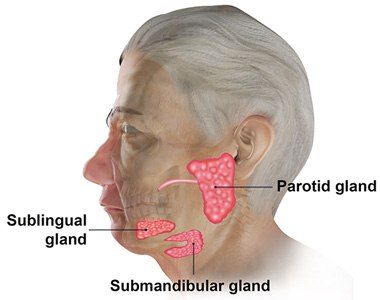Submandibular Salivary Glands
What are submandibular salivary glands?

The mouth is the first station where food gets digested. This digestion takes place due to the secretion of saliva. Saliva also keeps the teeth healthy, the mouth moist and helps you swallow. It is secreted by 3 major pairs of salivary glands, namely the parotid glands, submandibular glands and sublingual glands. The submandibular glands are located a little below the mandible or jaw bone. Its secretions enter the oral cavity through narrow ducts into the floor of the mouth.
What are indications for submandibular salivary gland surgery?
Submandibular salivary gland surgery is indicated to treat tumours, cysts, persistent blockages (sialolithiasis), drooling and chronic infections (sialadenitis) of the submandibular glands that are unresponsive to conservative treatments.
What are the consequences of not treating a submandibular gland condition?
Left untreated, the swelling of the salivary gland may grow, lead to cancer, blockage and infection, which are difficult to treat.
What are the alternative treatment options?
An infection in the submandibular gland can be treated with antibiotics. Small stones in the duct will pass through without any need for treatment.
How do I prepare for submandibular gland excision surgery?
You must fast for 6-8 hours prior to submandibular gland excision. Discuss all the regular medications that you are taking, and your doctor will advise you on those you can continue and the ones you should stop taking before the surgery.
How is submandibular gland excision surgery performed?
The process of excision of the salivary glands is performed under general anaesthesia. In case of swelling, tumour or a stone growing in the gland, the entire submandibular gland needs to be removed. However, if a stone is blocking one of the ducts that carry saliva to the mouth, your surgeon will only release the stone and retain the salivary gland.
To remove the gland, an incision is made around the upper part of the neck. The gland is then identified and your surgeon decides on the amount of tissue to be removed depending on the extent of damage. Once the gland is removed, the incision is closed with sutures.
If the gland is being removed due to an infection caused by a stone, a cut is made in the mouth, below your tongue and the stone in removed. The incision does not need to be closed.
A drain or small tube is also placed into the skin to remove any blood that may collect. The surgery takes approximately 45 minutes to an hour based on its complexity. If the excised gland is suspected for cancer, a sample is sent for examination by the pathologist.
What can I expect after submandibular salivary gland surgery?
After submandibular salivary gland surgery, you will be required to stay in the hospital overnight. You may be given pain medication and antibiotics to keep you comfortable.
Describe the stages of recovery.
Your wound will be covered with waterproof plastic dressings hence, care should be taken while washing and shaving. The drain is removed the next morning and the stitches are removed about a week followong the surgery. The scar may take a few months to fade away, but will gradually blend with the natural skin folds. You can resume your normal activities after a week, but strenuous activities should be avoided during the 1st week following the operation.
What are the outcomes of submandibular salivary gland surgery?
The excision of a salivary gland does not have an impact on the production of saliva, as there are many other salivary glands present in and around the mouth.
However, as with all surgical procedures, submandibular salivary gland surgery may be associated with some complications such as bleeding from the wound, infection or nerve damage, which may cause weakness of the lower lip, numbness of the tongue or restricted tongue movement.
How long will I be off work?
You will be able to resume work in about a week of the surgery.
What is the cost of the procedure?
We will provide you with a full explanation of the costs of the operation to assist you in your decision to proceed. The costs will vary depending on your level of private health insurance.
Ongoing research on submandibular salivary gland surgery include:
- Mizrachi A, Bachar G, Unger Y, et al. Submandibular salivary gland tumors: Clinical course and outcome of a 20-year multicenter study. Ear Nose Throat J. 2017 Mar;96(3):E17-E20.






